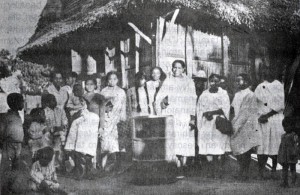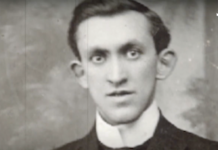By Berthe Raminosoa Rasoanalimanga —

Volahavana was born of royal lineage in Madagascar. Her father was well-respected as a healer in their village, but when he called on his many pagan gods for healing it made his daughter ill at ease.
She wanted to know the one true living God, if he existed. She asked her father, “Can God be seen?”
When she was about ten years old, God began to reveal himself to Volahavana through her dreams. Every night a tall man robed in white would take her to a large stone building. He would wash her feet and dry them with a towel, and then lay her on a bed and rock her to sleep. Then, at dawn, he would take her back home.
In another dream, she would see herself being caught in a net and lifted up to heaven. These two dreams came to her regularly until she was twelve years old.
After that, the dreams stopped, but in the middle of the day she often heard a voice calling her name. She would run home to see if her parents were calling her, but it just made them laugh; they thought she was crazy.
Pondering all these things, she would find refuge under a tree, crying and wondering about this God whom she wanted to know.
When Volahavana was 15-years-old she received several marriage proposals, but since she had never thought about marriage, she turned them down. Her parents were confused by her refusals, and sent her to live with her sister in Manakara. She only spent one year there, preferring to return to the village in order to not be tempted by city life.
Her father consults an oracle
Volahavana’s father consulted an oracle about his daugher’s unusual behavior and was overwhelmed by the answer. The oracle told him there was a greater spirit, a supreme God, living in his child.
As a result of this unusual encounter, her father’s thinking changed dramatically. He became convinced that the God who had revealed Himself to Volahavana was the supreme and just God, the God above all the other gods. From then on, he put his idols aside and told his family that they needed to obey the God of Volahavana. He also prophesied that he would die two years after the start of her ministry. This prophecy came true a few years later.
Her parents finally tired of her constantly turning down marriage proposals and pressured her into marrying Mosesy Tsirefo, a sixty-one year old catechist who was a widower and father. Volahavana had to take catechism classes in order to be baptized, which was a requirement for her Christian marriage. She learned the catechism lessons in two weeks, and was baptized in 1935 by Pastor Ramasivelo, taking Germaine as her baptismal name.
After her marriage, they went to live in Ankaramalaza, where her husband continued to teach her about the Christian religion. He was also helped in this by Pastor Rakotovao and Pastor Radafy.
Driving out an evil spirit
God called Volahavana to serve him when she was twenty-one years old. One of her step-sisters was sick, and possessed by an evil spirit. The Catechist Petera de Vohidrafy was present and was trying to exorcise her.
Volahavana was busy lighting the fire for cooking, when a voice suddenly ordered her to get up and to do something for the child. When she hesitated, an invisible force propelled her toward the girl. She put her arms around her step-sister and struggled with her for a long time in this manner. At length, the evil spirit that was in her said, “We are going to leave, because the One who is stronger than we are is coming.” Then a miracle happened: the young girl was healed and came back to her senses.
That miracle happened on August 1, 1941. The following evening, Jesus told the three people present at the healing, Volahavana, Mosesy Tsirefo, and Petera de Vohidrafy: “Get up, preach the Good News to the whole world. Chase the demons out. Commit yourselves…and do not delay. The time has come for the Son of man to be glorified in the Matitanana and Ambohibe tribes. I have chosen you for this mission. I command you to carry it out.”
The two catechists accepted readily, but Volahavana hesitated, saying she was still young, that she did not know the Holy Scriptures and that she would not know how to preach. Nonetheless, Jesus persisted, telling her: “Get up and spread the Good News all around.” She submitted, but asked Jesus to tell her ahead of time what she would have to say.
A new name
The Catechist Petera de Vohidravy had already begun his mission as an evangelist when Volahavana joined his work. Some from Petera’s group were jealous and mockingly gave her the nickname Nenilava, which literally means “big mother.” They did this to make fun of her height, because she was relatively tall for a Malagasy woman. Volahavana stood her ground and made no reply, but prayed: “Jesus, I’m ready to accept this ‘Nenilava’ nickname, but may your power be proclaimed throughout the world through it.”
Her prayer was answered, because she came to be known by that name through her mission and the miracles that happened through it. In fact, many people only knew her by that name.
As for her training, Jesus did not forget his promise, and granted her the gift of tongues, also teaching her the Holy Scriptures. Nenilava spent three months learning to speak the languages that she would eventually use to learn the Holy Scriptures. She was taught by Jesus himself. First, he taught her the twelve principal languages of the world, then he used them to converse with her. From that time forward, she spoke all twelve of those languages fluently.
Nenilava only used the gift of tongues to speak with Jesus, and not as the basis for her teaching. In the beginning of her ministry, she often spoke with Jesus in tongues, but later, she asked him to not use that gift when she was with other people, so that people with ill intentions would not be able to imitate her or use her to their own ends.
Unusual training
To teach her, Jesus used a white writing board and wrote on it in white as well. He wrote from top to bottom, as with Chinese writing. The lessons were held in a calm place either at home or in the forest, and the writing board was hung on the wall or from branches. Sometimes Jesus used a large book with very fine pages on which he wrote in white writing. In order to read it, Nenilava would kneel all the way down to the ground. During the lessons, Jesus would whisper words in her ear. When Mosesy Tsirefo saw her kneeling like that at home, he thought she was in prayer.
In order to teach her the Holy Scriptures, Jesus took her up to heaven seven times in three days. First, Jesus told her that she was going to die on Friday at 11:00 AM. The faithful from all over the district were told about it, and all those who could come did so – even distant parishes sent representatives. Pastor Rajaona Salema was present as well. There was a constant succession of Bible readings and prayers.
Nenilava laid down on a bed draped in white to wait for the appointed time. Her body was covered with a white sheet except for her face, which was left uncovered. The ascension of her soul took place slowly. All those present were around her bed praying and singing continually for three days, awaiting her return. Her parents became discouraged and thought that she would not be returning, as it seemed to be taking a long time, but the Christians who were there fasted until she came back.
After three days, Nenilava came back on Sunday at 8:00 AM. Coming down from the bed, she preached the word of God from I Corinthians 15:55, “Where, O death, is your victory? Where, O death, is your sting?” Jesus had taught her the four gospels.
Jesus then told Nenilava that she would have to fight with the dragon in order to harden her, because her mission would be one in which there would be no rest. This fight to the death lasted for three days. Jesus was always at her side. On the third day of fighting she defeated the beast in the name of Jesus. Following that victory, she fasted for two and a half months, during which time she ate only small white balls that looked like the host from the Lord’s Supper.
When her mission began, there were twenty-eight young people working with her in Ankaramalaza. She began her evangelization campaign in her own region. Her husband worked with her until his death in 1949.
After that, Nenilava was invited to come to various churches and began to leave her region, starting in Antsirabe, where the central headquarters of the Norwegian Lutheran Mission was located. She then went up to Imerina and the surrounding area. From there, she responded to many invitations to visit other regions — even out to theComoroIslands. In 1973, she also went abroad to follow up on invitations from several churches.
Accompanied by her collaborators and friends, Nenilava was accustomed to working with pastors and churches. Wherever she was, people came from all around to pray, to receive care or to be exorcised, and still others brought their sick. There were miracles: blind people recovered their sight, sick people were healed, and even personal or family problems were resolved. She kept the same practices wherever she went: prayer, preaching of the good news, exorcism, and the laying on of hands accompanied by encouraging and comforting words drawn from Bible verses.
In 1973, when the King of Norway asked her to describe her work, she answered: “I preach the gospel, I heal the mentally ill, I educate young delinquents, raise up infants and the elderly.”
Through her ongoing ministry, the Revival center of Ankaramalaza gradually became a place where people could come. Once people had been healed either physically or spiritually, most people settled there, because they didn’t want to go back home. Little by little, the center built a school for children and a dispensary.
Thanks to Nenilava’s ministry, many Malagasy, Europeans and Africans received Jesus, were delivered from the grasp of sin and enslavement to the Devil, and came to the knowledge of new life and the peace and light of the Holy Spirit. Nenilava never claimed to be a prophetess, but her deeds and her words of truth bore witness to her gift.
Nenilava’s childhood wishes were granted: she was able to meet this Almighty God that she wanted to know, and to know his power through her mission. Her wish to go up to heaven was also realized.
She died in 1998 in her home in the Revival Center in Ambohibao-Antananarivo and her body was carried to the village where she was born. Mourners buried her within the walls of the Revival Center of Ankaramalaza. Like a good, loving mother, she had set a good example and had left it to her children and to her co-workers to continue the work of evangelization and the works of good will that she had begun, in faith and in love for one another.
If you want to know God personally, go here
This article was written and researched by Mrs. Berthe Raminosoa Rasoanalimanga, Director of the Centre National des Archives FJKM (National Center for Madagascar Church of Christ Archives), and used by permission of the Dictionary of African Christian Biography.




Mark 16.15-18. A true disciple. Why aren’t WE doing these things?? Why aren’t I doing these things??
The answer is love: our love end Christ’s. Are we loving Christ in the same way? I don’t know. I wish I could, and that’s may prayer. But let’s read John’s gospel.
John 14.21-23
21 Whoever has my commands and keeps them is the one who loves me. The one who loves me will be loved by my Father, and I too will love them and show myself to them.”
22 Then Judas (not Judas Iscariot) said, “But, Lord, why do you intend to show yourself to us and not to the world?”
23 Jesus replied, “Anyone who loves me will obey my teaching. My Father will love them, and we will come to them and make our home with them.
God bless u.
Lin
Comments are closed.